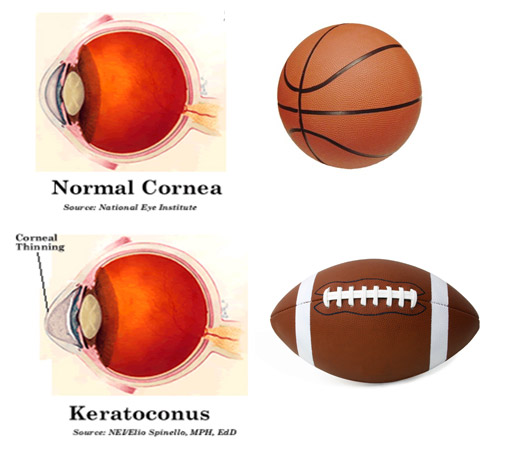
Keratoconus is a relatively common eye disease, effecting between 1 in 500 and 1 in 2000 Americans. The disease is characterized by a progressive degeneration of the cornea, the front clear window of the eye. The cornea becomes weak, thin, and irregular in shape, resulting in high levels of astigmatism that can interfere with the ability to see clearly. Often, keratoconus patients first require glasses and, as the disease progresses, contact lenses. Often, routine contact lenses do not work but specialized hybrid lenses may give patients good sight. If the condition progresses to a severe level, a corneal transplant may be required.
Corneal collagen cross-linking (CXL) strengthens the cornea by allowing it to re-form new cross-links between and within the collagen fibers. These new cross-links help strengthen the cornea, preventing further thinning and loss of vision. Many studies have shown that CXL can often prevent the need for a corneal transplant and allow patients to wear contact lenses or glasses more comfortably and safely again. CXL was first introduced in 1998 and is now performed for keratoconus patients in approximately 400 centers throughout the world. Through a research study, ClearView Eye and Laser Medical Center is now able to provide this investigational treatment to our patients using this technology.
Intacs™ Eye Implants are small crescent-shaped segments of plastic that are implanted on the periphery of your cornea to treat nearsightedness, astigmatism and keratoconus, a disease characterized by a thin, cone-shaped cornea.
Often, Keratoconus is an inherited condition in an autosomal dominant fashion, so family members should be screened. The diagnosis is often made when one is in the late teens to early 20's but has occurred in children as young as age 6.
The symptoms of this disease may be similar to many other eye problems, making it important to raise awareness about this disease. Eye rubbing may worsen the course and should be avoided. The symptoms include:
Change Your Vision,
Change your Life!
Copyright © 2024 Clearview Eye and Laser Medical Center in San Diego, California. All rights reserved.
LASIK is a medical procedure with risks involved and isn't right for everyone. Individual results may vary. Talk to your eye doctor and consider both the risks and benefits before having the procedure. Additional information can be found at our website or at fda.gov. the material contained on this site is for informational purposes only and is not intended to be a substitute for professional medical advice, diagnosis, or treatment. Always seek the advice of your physician or other qualified health care provider.